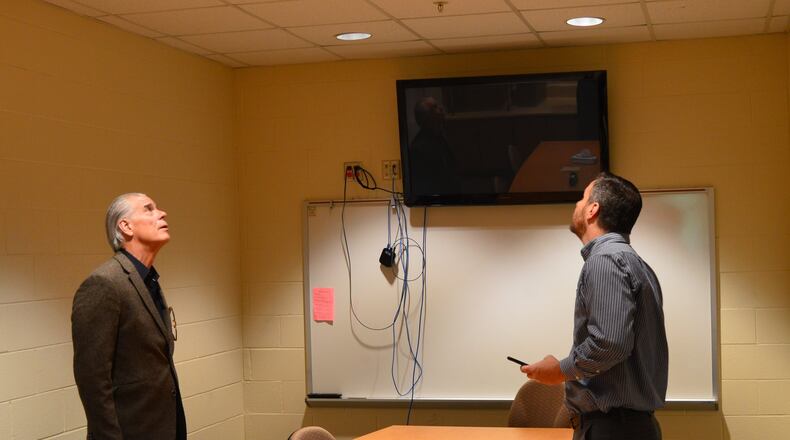Bogan, which has been in use 12 years, was the subject of an energy audit last year to determine possible savings and the retrofit for LED lighting was recommended. That audit was conducted by Heapy Solutions, from Dayton.
Jason Brown, of Heapy, conducted a walk-through of the building July 25 as the retrofit project was nearing completion with Mike Davis, Talawanda district treasurer and CFO. The board of education approved the retrofit project at the December board meeting.
Davis said the advantage to the project is a long-term savings. LED lights are expected to last 20 years in addition to savings in annual electricity costs.
“Jason and his team were tasked with finding savings. Why spend more on your energy bill than you have to?” Davis asked.
Brown said the rebate from Butler Rural Electric was “maxed out,” the most available for a project from the cooperative.
He started the tour on the school’s parking lot, noting all those lights were retrofitted with LED lights, including those at the base of the flagpole.
“The street sign was not working. We had the electrician check and he found it was disconnected,” Brown said. “It was retrofitted with LED.”
Davis said the district spent $661,000 last year on electricity and gas, with the Bogan expense at $104,000 for electricity and $12,00 for propane.
Brown called the switch to LED “the lowest-hanging fruit” after the energy audit because of the payback and initial expense. He said the savings would provide a less than five-year payback on the cost and LED tubes would last longer than fluorescent.
“The life in the bulbs is 15 to 20 years,” Davis echoed. “In 2038 the bulbs should start to burn out.”
Brown said the savings come on multiple fronts.
“LED tubes consume about half (the energy) of fluorescents and there is less heat so it stresses the air conditioning less,” Brown said, adding there are two variations on the light produced, one brighter, and they sought staff input on which to use. “One is softer. We did two rooms (with both in half the room) so teachers and administrators were able to see them side-by-side.”
The softer illumination proved to be the preferred option because children tend to be more restless in the brighter lighting. In fact, Davis pointed out lights in the classrooms used for special education students were softened even more by using blue covers over them since blue is more soothing.
Although the LED retrofit was “low-hanging fruit,” there are some issues on the horizon for the Bogan building. The boilers and chillers are expected to have life spans of 15 to 20 years and, at 13 years, have a limited time remaining.
Davis said he has that possibility on his financial radar and is aware of it and said the energy audit is helping with that concern. He said the biggest issue is the possibility of having them go out in the height of winter or warm spring or fall periods.
Brown said he expects the district to get maximum life out of them, however.
“The equipment has been well-maintained to extend its life,” he said.
When the walk-through was conducted July 25, Brown said there were no fluorescent tubes left in the building and work was winding down on a few final details. As if to illustrate that, Doug Dodd, of Becker Electric Supply, entered the building carrying several bulbs.
He said there were several overhead lights with deep hoods on them which prevented use of bulbs they had provided for the project and he was bringing in a couple to try in their place to make sure they had those lights working.
About the Author
